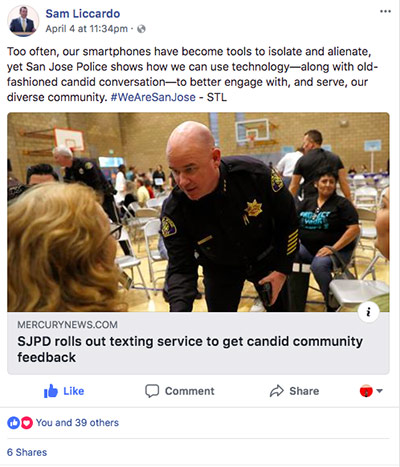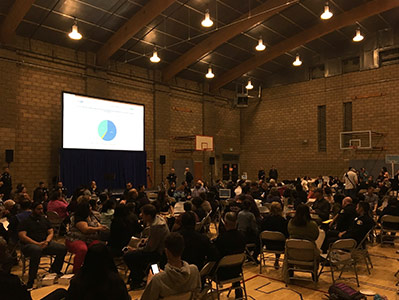Contact Us
To provide feedback on the Community Policing Dispatch, e-mail the editorial board at CPDispatch@usdoj.gov.
To obtain details on COPS Office programs, publications, and resources, contact the COPS Office Response Center at 800-421-6770 or AskCopsRC@usdoj.gov

U.S. Department of Justice
Office of Community Oriented Policing Services
Washington, DC 20530
Traditional community policing is about officers showing up, listening, and forming lasting partnerships with residents in their neighborhoods — and it has never seemed less feasible. Then again, community policing has never looked less “traditional.” The “Wild Wild West” of community policing is now online, as police departments initiate community engagement on Facebook, Twitter, Nextdoor, YouTube, Snapchat, Neighbors, GroupMe, Mobile PD, and more.
The good news is that “digital community policing” can reach a lot of people more quickly and inexpensively than traditional methods, like knocking on doors. Most police departments have turned to technology as a force multiplier to help them maximize their positive impact given their limited resources.
The bad news is that, depending how digital platforms are used, police departments are at risk of creating echo-chambers, encouraging “hyperactive ‘crime and safety’”1 discussions, and increasing racial profiling in neighborhoods.
The pros and cons of the complicated relationship between communities, police, and technology is front and center today. Consider two examples:
1) Nextdoor
Nextdoor has struggled with people using the platform to target minorities in wealthy neighborhoods in the name of reporting “suspicious activity.” The fallout from racial profiling accusations on Nextdoor is ongoing, although the company has made strides in addressing the problem. Of course, this is a problem far greater than Nextdoor. “BBQ Becky,2” for example, recently gained notoriety for reporting a black family who was barbecuing at Lake Merritt in Oakland, CA. In true 21st century fashion, BBQ Becky’s tirade was filmed on a cell phone and went viral, leading to a massive “BBQing While Black” protest picnic.
Law enforcement isn’t responsible for policing racist content online, but they are obligated to respond to calls for service that stem from online discussions. When residents contact the police about “suspicious” people in their neighborhood, even when dispatchers detect overt racism from the callers, officers have to show up. Online comments — whether on Nextdoor, Facebook, Twitter, or other message boards — have created a new environment where residents can inflame bias and fear, and this impacts policing in the real world.
2) Neighbors
Neighbors, an app created by the smart doorbell maker Ring, is one of the newest tools in this space. Users can share ‘photos and videos of package thieves, burglars and other suspicious activity.” It’s the “suspicious activity” part that becomes risky. After all, community policing at its core relies on the “see something, say something” principle. But if what you’re seeing and saying is that someone looks suspicious because of their race, technology plays a role in exacerbating these underlying problems in a community.
Because Neighbors uses photos and video footage instead of residents’ descriptions, the app may provide police departments with better information to determine whether or not behavior is indeed suspicious. However, if the Facebook data scandal has taught us anything, it’s that privacy concerns don’t become less pressing as technology becomes more familiar. Police departments that rely on footage that is obtained without bystanders’ knowledge or consent, whether from body cams, smart doorbells, or drones, risk alarming the public.
Police departments face a challenging situation online. Best practices for digital community policing are still being established, but the public increasingly expects real-time information and greater transparency from their local department. Meanwhile, police departments understandably worry that using technology will create more problems than they’ll solve.
We know that police departments now brace themselves for crises, both online and offline. Police chiefs often tell us that they have to be prepared because “it’s not a question of if, it’s a question of when.” So what can police departments realistically do? The answer lies in effective communication, and there are three ways to use technology to help:
1) Tell the public what you know
Police departments can use technology to effectively disseminate information with the public before, during, and after a crisis. Departments can share information with the public about how they intend to handle officer-involved shootings, for example, even if (or especially if) no incidents have recently taken place.
Communication becomes even more important during a crisis and it can impact community-police relations in your city for years to come. A recent My90 focus group found that, even when it came to a fatal police shooting of an unarmed resident, residents’ views toward the police were strongly influenced by how clearly and effectively the police department communicated with the public. An immediate statement that provides concrete details about the department’s policies and timeline, shared on all available platforms, is a positive action that departments can take after any negative incident.

San Jose Mayor, Sam Liccardo, posts about San Jose Police Department’s initiative with My90.
2) Ask the public what you don’t know
Technology moves at the speed of light, and getting good data on public opinion usually moves … a bit slower than that. Are you wondering if your department should obtain its first drone? Are you curious if the public understood your department’s recent statement about your stance on immigration enforcement? Are you looking for more data about community sentiment in your city?
All departments have questions they’re trying to answer, and one under-utilized option is to simply ask the public what they think. This can be done through surveys, community panels, focus groups, and more. New options leverage technology to effectively obtain this kind of information while protecting users’ privacy throughout the process. My90, which uses text messages and an online platform, is one of these options.
3) Keep the discussion going
It’s not enough to ask the public what they think once a year and put the results on a shelf. Traditional surveys are evolving, and technology means that there is a new opportunity to create an ongoing conversation with local residents. However, many departments are still hesitant to do so. A report from the Urban Institute found that a third of departments don’t respond to critical comments on online platforms and simply use their accounts to post information instead.
Engaging with critics may seem counterintuitive, but ignoring negative feedback is a missed opportunity. By engaging people who are angry, fearful, or confused, police departments can build trust that ultimately translates to safer conditions for residents and officers alike.

San Jose police officers use My90’s live event tool to engage community and measure feedback at neighborhood forums. (Photo: San Jose Mercury News).
Racial profiling, vigilantism, privacy concerns — these are all complicated issues, and bringing them online raises new risks. Digital community policing is worth it, and in a world where most people are glued to their phones, departments have to meet communities where they are. This doesn’t replace the need for spending time face-to-face. Instead, it highlights the need to use technology in a way that brings all residents into the conversation equally. For many residents, they may be more likely to keep an eye on a department’s Twitter account than to show up at a town hall, at least at first. If departments are committed to using technology to improve communication, increase transparency, and strengthen relationships, they just may be more likely to fill seats when it comes to “old-fashioned” community policing initiatives as well.
Kona Shen
Co-founder and CEO, My90
References:
1.The Police Officer ‘Nextdoor’. The Atlantice. Kaveh Waddell May 4, 2016. https://www.theatlantic.com/technology/archive/2016/05/nextdoor-social-network-police-seattle/481164/
2.A white woman called police on black people barbecuing. This is how the community responded. Gianluca Mezzofiore. May 22, 2018. https://www.cnn.com/2018/05/22/us/white-woman-black-people-oakland-bbq-trnd/index.html
Subscribe to Email Updates
To sign up for monthly updates or to access your subscriber preferences, please enter your email address in the Subscribe box.






